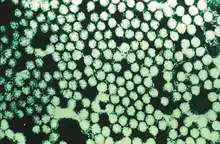Foot-and-mouth disease virus
Foot-and-mouth disease virus (FMDV) is the pathogen that causes foot-and-mouth disease.[1] It is a picornavirus, the prototypical member of the genus Aphthovirus. The disease, which causes vesicles (blisters) in the mouth and feet of cattle, pigs, sheep, goats, and other cloven-hoofed animals is highly infectious and a major plague of animal farming.
| Foot-and-mouth disease virus | |
|---|---|
 | |
| Electronmicrograph of Foot-and-mouth disease virus | |
| Virus classification | |
| (unranked): | Virus |
| Realm: | Riboviria |
| Kingdom: | Orthornavirae |
| Phylum: | Pisuviricota |
| Class: | Pisoniviricetes |
| Order: | Picornavirales |
| Family: | Picornaviridae |
| Genus: | Aphthovirus |
| Species: | Foot-and-mouth disease virus |
Structure and genome

The virus particle (25-30 nm) has an icosahedral capsid made of protein, without envelope, containing a positive-sense (mRNA sense) single-stranded ribonucleic acid (RNA) genome.
Replication
When the virus comes in contact with the membrane of a host cell, it binds to a receptor site and triggers a folding-in of the membrane. Once the virus is inside the host cell, the capsid dissolves, and the RNA gets replicated, and translated into viral proteins by the cell's ribosomes using a cap-independent mechanism driven by the internal ribosome entry site element.
The synthesis of viral proteins include 2A 'cleavage' during translation. They include proteases that inhibit the synthesis of normal cell proteins, and other proteins that interact with different components of the host cell. The infected cell ends up producing large quantities of viral RNA and capsid proteins, which are assembled to form new viruses. After assembly, the host cell lyses (bursts) and releases the new viruses.[2]
Recombination
Recombination can occur within host cells during co-infections by different FMDV strains.[3] Recombination is common and a key feature of FMDV evolution.[4]
Serotypes
Foot-and-mouth disease virus occurs in seven major serotypes: O, A, C, SAT-1, SAT-2, SAT-3, and Asia-1. These serotypes show some regionality, and the O serotype is most common.
See also
References
- Carrillo C, Tulman ER, Delhon G, et al. (May 2005). "Comparative Genomics of Foot-and-Mouth Disease Virus". J. Virol. 79 (10): 6487–504. doi:10.1128/JVI.79.10.6487-6504.2005. PMC 1091679. PMID 15858032.
- Martinez-Salas E, Saiz M, Sobrino F (2008). "Foot-and-Mouth Disease Virus". Animal Viruses: Molecular Biology. Caister Academic Press. pp. 1–38. ISBN 978-1-904455-22-6. Archived from the original on 2012-02-07. Retrieved 2009-01-20.
- Ferretti L, Di Nardo A, Singer B, Lasecka-Dykes L, Logan G, Wright CF, Pérez-Martín E, King DP, Tuthill TJ, Ribeca P. Within-Host Recombination in the Foot-and-Mouth Disease Virus Genome. Viruses. 2018 Apr 25;10(5):221. doi: 10.3390/v10050221. PMID 29693634; PMCID: PMC5977214
- Aiewsakun P, Pamornchainavakul N, Inchaisri C. Early origin and global colonisation of foot-and-mouth disease virus. Sci Rep. 2020 Sep 17;10(1):15268. doi: 10.1038/s41598-020-72246-6. PMID 32943727; PMCID: PMC7498456